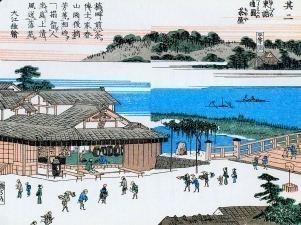We sort of blew Kyoto. I don’t blame Kyoto. This was our fault.
We were going to Kyoto because we wanted to ride the shinkansen. I have been wanting to ride the shinkansen since I first heard of it in fourth grade, when we did a class unit on Japan. We learned a whole lot about textiles, as I recall. I’m not sure the word “textile” was ever defined for us, or maybe I slept through that part. We also learned about sushi, which scared the hell out of me, since I was a picky eater.
There are lots of shinkansen lines, but we decided to do Kyoto because we got a reasonably priced train/hotel package and because Kate Williamson’s book [A Year in Japan](http://www.amazon.com/dp/1568985401/?tag=mamstesgrubshack) is set there. The book is an illustrated chronicle of Williamson’s year spent living in Kyoto, and one of the most memorable pages shows people skipping across stepping stones set in the Kamo river, which runs through central Kyoto. Iris really wanted to cross those stepping stones. (Me too.)
You don’t need me to tell you that the shinkansen is completely awesome. Painted stripes on the platform show you where to stand, which is important, because the train arrives precisely on time and dwells on the platform for less than two minutes before proceeding.

We rode the Nozomi, which is currently the fastest shinkansen service. Top speed: 186 mph. I was a little worried that the shinkansen might seem anticlimactic, just fast rather than really fast, or worse yet so smooth that it didn’t even feel fast, like a plane that happens to be flying on the ground.
No worries, I felt totally sick. It felt every bit of 186mph, ten times more of a thrill ride than the recycled Disney submarine ride we went on the previous day. We whipped through town and countryside and mostly lots and lots of tunnels. A woman in a smart uniform walks through the train selling tea and coffee and sandwiches and candy, and Iris bought some chocolate sticks with embedded rice crackers–like Japanese Nestle Crunch, except they come four tiny sticks to a package and sixteen tiny packages to a box. Each cellophane pack has a different animal on it. “Here,” said Iris, “you can have wild boar and I’ll take pygmy hippopotamus.” We opened our candy. “Hey, they’re the same,” said Iris, apparently disappointed that her chocolate was not hippo-flavored.

When I caught my first glimpse of Mt. Fuji, [I kind of flipped out](http://twitter.com/mamster/status/11342392228), but no more so than the middle-aged Japanese women across the aisle. Something about the mountain undoes the stiffest upper lip. The train goes preposterously close to it; it’s the opposite of a zen view. You can practically lick it. (We got much, much closer than in the photo, but after I took this picture I was too busy panting against the glass to take any others.)

Before boarding the train, we bought our bento boxes at Tokyo Station. Somehow I’d envisioned Tokyo Station as being like Grand Central Terminal, with soaring ceilings. It’s actually Penn Station–the current one, not the old one–but clean and with better shopping. Like, insanely great shopping. We skipped the fancy chocolates, but the delis alone are worth the trip. Iris chose a tonkatsu bento and I got assorted sushi. She liked her pork, and ate little else, but I think the side dishes make the bento. I had an oden-like stew of assorted fish cakes and burdock root. Iris had a little seaweed salad and some kinpira gobo to go with her pork. It was really just as good as I imagined it.
We rested for a while at our hotel in Kyoto before heading to Gion, the preserved historic district.
Here’s how we blew Kyoto, item one: we didn’t really do any research before arriving there. So when we got to the river, no stepping stones.

Later I looked it up and they were maybe a mile upstream. But we did find the river, and walked across a bridge and down a cherry blossom-lined lane. Which was pretty and, well, kind of boring. On the west bank of the river, however, is an alley full of restaurants, called Pontocho. We stopped at the first place that looked good, a sukiyaki restaurant that was mildly disastrous.
At home, we serve sukiyaki with a bowl of beaten raw egg on the side for dipping the beef and other ingredients in before eating. Well, I do, at least. Iris and Laurie aren’t into that.
So we went into this place and asked about sukiyaki, and they took us up to the fifth floor, overlooking the river. This was the view _from our table:_

The waitress asked if we wanted egg with our sukiyaki. I said sure. She cracked eggs into two bowls and beat the eggs, cooked our sukiyaki, and then, to Iris’s horror, pulled out nearly all the beef and plunked it right into the bowl of raw egg. This was the only thing in Japan served to Iris that she refused to try. And can you blame her?
So we did the only sensible thing. I wolfed down all the sukiyaki, and then we had a second dinner of stuff grilled on sticks: chicken wings, yakitori, shishito peppers, and chicken skin. The place took great care to expose every fatty bit of chicken to the heat of the grill, and it was all terrific.
The next day had similar ups and downs.
**Next time:** The Fox Goddess and Uji.










